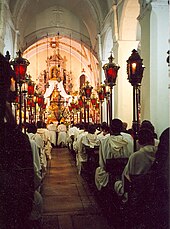Cross procession in Hvar
The procession of the cross in Hvar (Croatian procesija za križem ) is a centuries-old rite that has been held on the Croatian island of Hvar every year on the night from Maundy Thursday to Good Friday since the 16th century .
Six processions of penitents go all night clockwise from place to place and from church to church on the island without meeting each other. The places are Jelsa , Pitva , Vrisnik , Svirče , Vrbanja and Vrboska . A procession begins and ends in each place. Each procession returns to its starting church on Good Friday. It is a special honor to be a cross-bearer in the procession . Young men wait years for their vows or their fathers' vows to carry the heavy cross to be fulfilled. They meet regularly in the months before and practice for this honorable day. The procession is guided by the traditional belief in the weeping of the Mother of God , which can be heard in the churches of Hvar during the so-called “Night of Torment”. During the procession, the participants sing old traditional religious songs.
Before the procession, a cross is covered with a black veil in the parish church of the Assumption of Mary in Jelsa. Meanwhile, three men in white tunics are kneeling on the bench under the cross . They only wear white woolen stockings on their feet. The man in the middle is the bearer of the cross. The other participants in the procession hold candlesticks and are also dressed in white tunics. The priest hands the cross, which weighs 18 kg, to the cross bearer and gives the last instructions before the start of the great night procession through the five other villages, from which the other groups start the procession at the same time.
As a sign of sacrifice for the entire congregation, the last part of the way is conquered by the bearer of the cross alone in a hurry. He walks with the heavy cross until the priest takes him in his arms.
At the respective end of the processions, the women have now set up tables and chairs for a feast, at which the cross-bearers and other men involved are entertained by the women. For several weeks you kept the best dishes for this moment in order to prepare the feast. The men eat, the women serve.
The ritual is around 500 years old and in this form unique in the world. In Seville in Spain and some cities in southern Italy such as Taranto there are similar processions.


